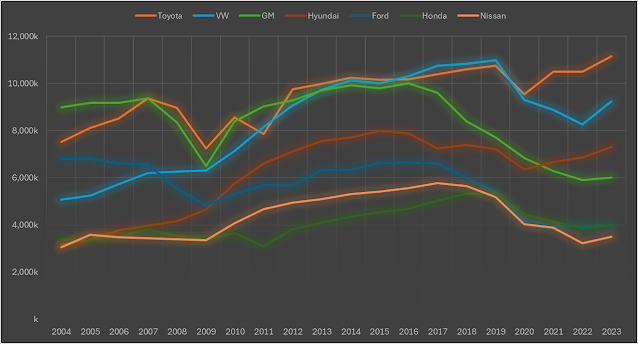The Shifting Landscape of the Automotive Industry: Challenges, Triumphs, and the Future of Mobility
Over the past 20 years, the automotive industry has experienced dramatic changes and challenges, much like a gripping drama. The once-dominant automakers saw their empires crumble while unexpected new players emerged, completely shifting the industry's balance of power. These changes are not just about business; they're a saga of technological innovation and shifts in the global economy. In this blog, we will explore the fascinating history of these transformations in the automotive industry and discuss how we can prepare for the future.
1. The Collapse of GM and the 2008 Financial Crisis
The 2008 global financial crisis shook the automotive industry to its core. At the time, GM was the world's largest automaker but faced a severe downturn and filed for Chapter 11 bankruptcy in 2009. GM's sales, which stood at 9,370,000 vehicles in 2007, plummeted to 6,500,000 units in 2009. GM's heavy reliance on the U.S. market left it vulnerable to the financial crisis, ultimately costing it the top spot in the industry. This serves as a stark reminder of the risks associated with overdependence on a single market.
GM's collapse was a symbolic event that highlighted the shock and uncertainty in the U.S. economy. The U.S. government's intervention and restructuring efforts helped GM survive, earning it the nickname "Government Motors." This episode underscores how crucial it is for companies to adapt quickly and decisively in times of crisis. Today’s businesses can learn valuable lessons from GM's experience about resilience and strategic adaptation.
2. The Rise of the Chinese Market and Volkswagen’s Success
The Chinese automotive market began its explosive growth following the 2010 Shanghai Expo. Volkswagen seized the opportunity early, selling more than 1,500,000 vehicles in China in the early 2010s and reaching 10,300,000 units globally by 2016, claiming the title of the world's largest automaker. Meanwhile, Toyota struggled with its late entry and faced challenges due to anti-Japanese sentiment, selling only 700,000 vehicles in China during the same period. This example illustrates the importance of proactively entering new markets to seize opportunities.
The rapid expansion of the Chinese market was seen as a golden opportunity by global automakers. Volkswagen adapted well to the needs of Chinese consumers and earned their trust through a diverse lineup. Conversely, Toyota, which entered the market later, found it challenging to gain a foothold. Ultimately, a company’s ability to swiftly adapt to new markets and devise strategies tailored to local demands determines its success.
Yearly Sales of Major Automakers
The table below shows the yearly sales of major automakers from 2004 to 2023, providing a clear picture of how each company grew and the challenges they faced over time.
3. Hyundai’s Rise, Volkswagen's Growth and Recent Decline
The COVID-19 pandemic in 2020 presented an unprecedented challenge to the global automotive industry. While major U.S. and European automakers had to halt their production lines due to lockdowns, Hyundai managed to keep disruptions minimal thanks to South Korea's effective pandemic response and stable supply chain management. As a result, Hyundai climbed to 3rd place in global sales, selling approximately 3,744,000 units in 2020 with minimal declines. This resilience serves as a prime example of how adaptability in a crisis can set companies apart.
Hyundai’s success was more than just continuity of production. By securing the stability of its supply chain and consistently meeting global demand during the pandemic, Hyundai strengthened its brand trust among consumers. This kind of resilience is critical in earning long-term loyalty from both consumers and partners.
On the other hand, Volkswagen faced challenges due to its overreliance on the Chinese market. Historically, Volkswagen had leveraged China's rapid growth to become the global sales leader. However, heavy investments and reliance on the Chinese market eventually exposed vulnerabilities within its domestic operations. Volkswagen’s dependence on the Chinese market led to a drop in competitiveness at home, and as Chinese electric vehicle manufacturers rapidly emerged, Volkswagen found itself grappling with declining market share, domestic plant closures, and pressures to restructure. This situation clearly underscores the risks associated with relying too heavily on one market and highlights the importance of diversification.
4. The Electric Vehicle Revolution and Emerging Leaders
The automotive industry's most significant transformation today is the shift toward electric vehicles (EVs). In 2022, Tesla sold more than 1,300,000 EVs globally, establishing itself as the industry leader. Traditional automakers, who had dominated during the internal combustion engine era, are now struggling to transition to EVs while Tesla and other new players rapidly capture market share. Volkswagen has also faced difficulties transitioning, selling only about 570,000 EVs in 2023, falling behind its competitors. Hyundai, selling around 410,000 EVs in 2023, has been trying to establish a foothold but still faces significant challenges.
The EV era is more than just a transition from gasoline to electricity; it represents a complete redefinition of what a car can be. The combination of battery technology, charging infrastructure, and smart features connected to autonomous driving is reshaping the automotive landscape. Tesla has revolutionized the concept of vehicles by making them not just modes of transport but advanced IT devices that can be continually updated. This approach is setting a new standard that traditional automakers must strive to meet. A company's ability to swiftly embrace these changes is key to its future competitiveness.
Preparing for the Future: Challenges Ahead
The transformation of the automotive industry over the past 20 years offers several crucial lessons. First, overdependence on a particular region can be risky. Second, adopting new technologies and being adaptable to changes is essential for survival. Lastly, responding quickly and decisively during times of crisis is what sets companies apart. As we move into an era of electric and autonomous vehicles, traditional automakers must learn from past experiences to navigate the challenges ahead and become leaders in the new landscape. The future is uncertain, but it is filled with opportunities for those who are prepared to embrace change and innovation.




